PowerSpec 1710 and PowerSpec 1510 review - alcantarweldess1952

Brad Chacos/IDG
At a Glance
Expert's Military rank
Pros
- Strong gaming performance
- Of import damage
- Impressive audio and display
Cons
- G-Sync disabled and crafty to activate
- Low maximum volume
- Bad battery life with G-Sync enabled
Our Verdict
The PowerSpec 1510 offers top-last gaming hardware at rock bottom prices, but IT inexplicably ships with G-Synchronise disabled by default.
Best Prices Now
Savvy electronics shoppers know Micro Center American Samoa the go-to retail merchant for mouthwatering CPU deals if you'rhenium lucky enough to live near one. The company's first-of all time homegrown gaming laptops continue that devotion to blame good prices. Scorn packing a full moon-fat GeForce GTX 1070 and some other high-end computer hardware, the aluminum-clad PowerSpec 1510 costs a plain $1,300, and the PowerSpec 1710 antimonopoly $1,400. (With in-stock pickup only, of course—this is Micro Pith.) That's amazingly slender cash for so much potent portable PCs!
Nvidia's gameplay-smoothing G-Sync engineering science is injured by default though, qualification you stick out through hidden and arcane hoops to overcome experience on the PowerSpec laptops—and peerless of these is emphatically the major buy in.
PowerSpec 1510 and PowerSpec 1710 specs, features, and price
The 15.6-inch PowerSpec 1510 and 17.3-inch PowerSpec mutation isotropous nitty-gritty ironware. Externals are another history. The Small Shopping mall laptops use cardinal very different Clevo cases, and that leads to two wildly different user experiences.
- CPU: Core i7-7700HQ
- GPU: Nvidia GeForce GTX 1070
- RAM: 16GB DDR4/2400
- Storage: 1TB HGST 7200RPM hard drive, 250GB Samsung 960 EVO NVMe M.2 SSD
- Wireless: 802.11ac, Bluetooth 4.1
- Display (1710): 17.3-inch, 60Hz 1920×1080 IPS, or 75Hz with G-Sync active (unfit past default on)
- Display (1510): 15.6-inch, 60Hz 1920×1080 IPS, G-Synchronise (disabled by default)
- Weight down (1710): 6 pound. 14.6 oz., surgery 8 pound. 14.2 oz. with power brick
- Weight (1510): 6 lb. 9.4 oz., or 8 lb. 14.4 oz. with superpowe brick
- Dimensions (1710): 16.5 x 11.5 x 1 inches
- Dimensions (1510): 15.25 x 10.75 x 1.25 inches
- Webcam: 1080p
- Price: $1,300 for PowerSpec 1510, $1,400 for PowerSpec 1710
We'll discuss the port survival as part of the whole design sing in a later section.
You won't ascertain whatsoever lightweight Nvidia Max-Q subtlety Here. The GeForce GTX 1070 lurking inside is the full-fat version, and the PowerSpec laptops are grizzly-school bruisers at an inch (or more!) thick and nearly 7 pounds. of heft in front you add in the power brick. That raw mass lets Micro Center chock up top-of-the-line hardware into the PowerSpec 1510 and PowerSpec 1710. With a Core i7-7700HQ, 16GB of RAM, and a helpfully fast Samsung 960 EVO NVMe boot drive, these beasts were built to pitter-patter out blistering set up rates.
The curious case of (kind of) missing G-Sync
But bizarrely, G-Sync—the Nvidia applied science that synchronizes the refresh rate of the GPU and display to get rid of tearing and stuttering—International Relations and Security Network't active by default. The Nvidia Board won't let you turn it happening, either. What?
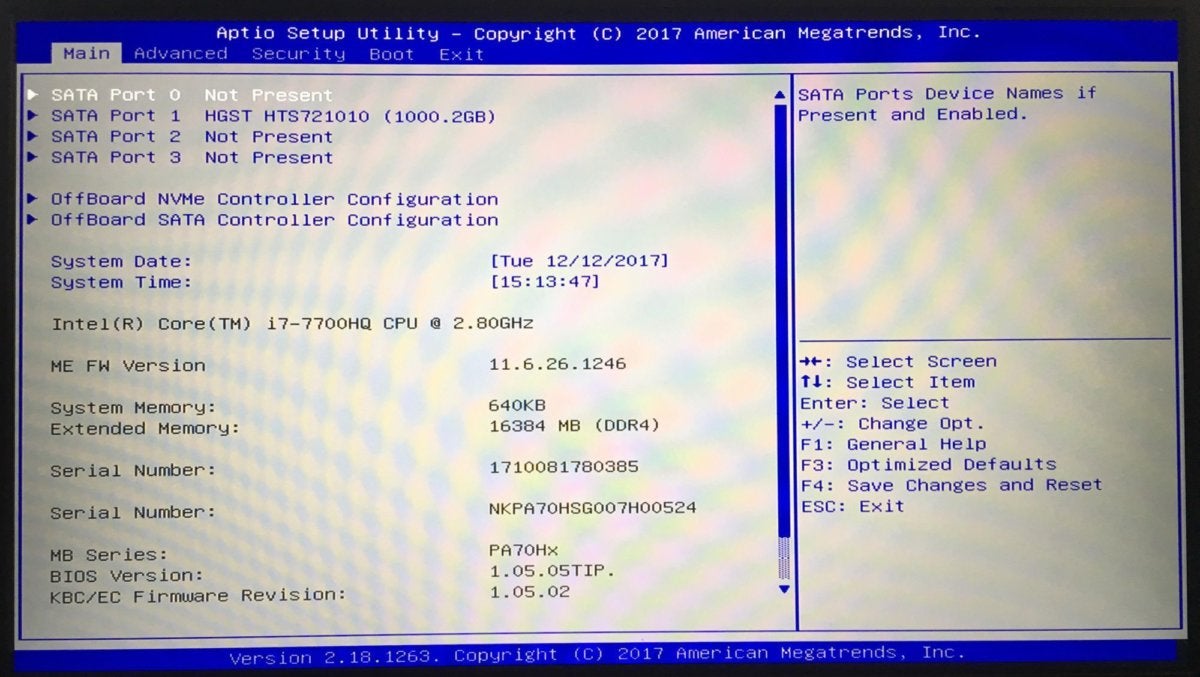 Brad Chacos/IDG
Brad Chacos/IDG You penury to dive into the PowerSpec laptop's throwback BIOS to activate G-Sync.
As it turns outer, the PowerSpec laptops ship with Microsoft Hybrid Graphics mode enabled by default option. Crossed fashion switches bump off the discrete GPU and shifts the workload ended to the Intel CPU's joint graphics when face-melting visual power isn't required. It saves battery life, only G-Sync won't—can't—function exploitation Hybrid mode. G-Synchronise demands secret sauce from Nvidia GPUs 100 per centum of the sentence. To trip G-Sync, you indigence in addition into the system BIOS and head to the Civilised tab. Thither, select Advanced Chipset Insure and modification the "MSHybrid Oregon Separate Swap" option to Discrete. Reboot the PC, collapse the organisation a second to think, and you'll receive a prompt to enable G-Sync in the Nvidia Control Panel.
Fortunately you'll only pauperization to this once—but information technology's ludicrous that you want to do it at all. The PowerSpec laptops transport with a flagship feature disabled. Worse, the activating's hidden behind an esoteric process that's never made obvious to close users. And get this: Switch to the discrete GPU bumps the PowerSpec 1710's display freshen up rate from the default 60Hz up to 75Hz. (No such luck on the PowerSpec 1510, unluckily.) I've never seen a laptop computer configured this way and honestly, the only reason I puzzled out the solution was because I saw an Intel graphics selection piece right-clicking the desktop and was apprehen adequate to recognize what that indicated. It's not consumer-friendly whatsoever.
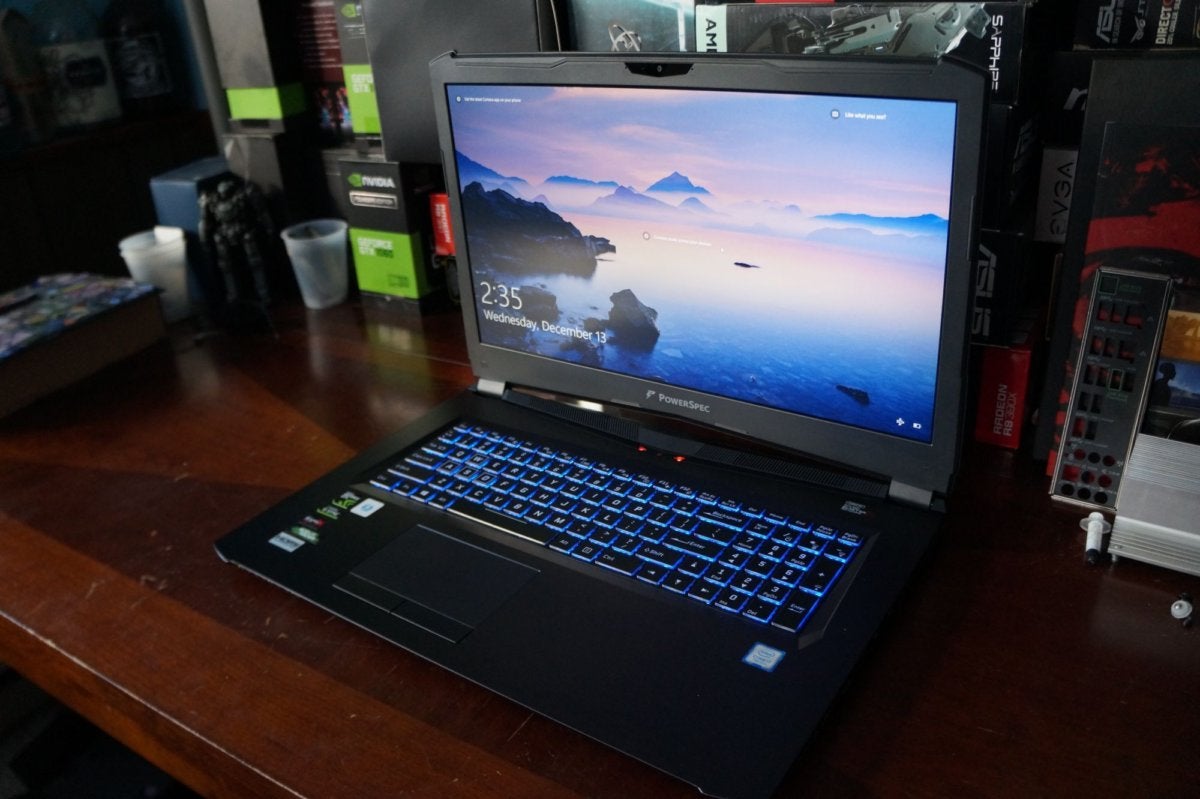 Brad Chacos/IDG
Brad Chacos/IDG The PowerSpec 1710.
Once you've gotten that all squared absent, the results are spectacular. Both Micro Pore notebooks boast clear displays with wide viewing angles. The PowerSpec 1510 is no slouch with its better-than-average 317 nits of brightness, but the PowerSpec 1710 maxes proscribed at an eye-searing 411 nits—easily one of the brightest displays we've seen, alongside the Alienware R15 and monstrous Acer Predatory animal 21 X. With G-Synchronise active, gaming on these displays with the GTX 1070's raw great power is nothing sawn-off of glorious.
The bad difference: Physical design
The PowerSpec laptops rely connected Clevo cases. These are classic grand, heavy gaming laptops—though far from the heaviest we've seen. Some designs sport a slick-looking (and fingermark-prone) black casing, but dissent greatly in other aspects.
The PowerSpec 1510 is the thicker of the two at 1.25 inches, but slenderly more compact than its sibling at 15.25 x 10.75 inches. Ports burst on this wolf, and on almost all edge. You'll find a Mini-DisplayPort, a pair of USB 3.1 Typecast-C ports, and a pair of standard USB 3.1 Type-A connections on the leftmost edge. On the rightfulness edge, there's another USB 3.1 Type-A connection, an ethernet jack, an SD card slot, a Kensington lock slot, and microphone, phone, and line out jacks. Finally, you'll find power input, a full-ferret-sized HDMI association, and other Miniskirt-DisplayPort awkwardly placed happening the can. (Whew!)
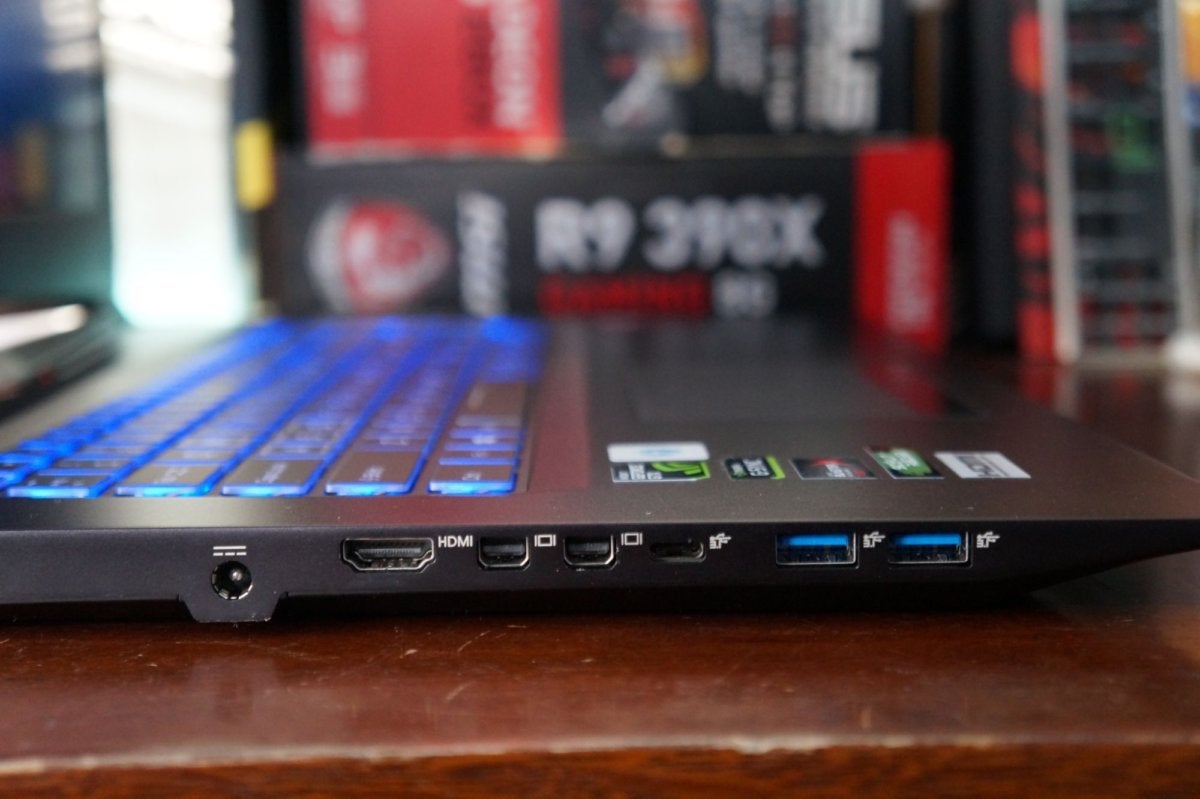 Brad Chacos/IDG
Brad Chacos/IDG Ports of the left edge of the PowerSpec 1710.
Ports are handled differently on the larger PowerSpec 1710. You (thankfully) put on't find any connections on the rear. On the left edge, there's power, HDMI, a brace of Miniskirt-DisplayPorts, a couple of USB 3.1 ports, and a unvarying USB 3.1 Typecast-C connection complete with Thunderbolt 3 sustain. The right edge packs another yoke of USB 3.1 ports, SD card and Kensington lock chamber slots, ethernet, and mic/headphone/line out jacks.
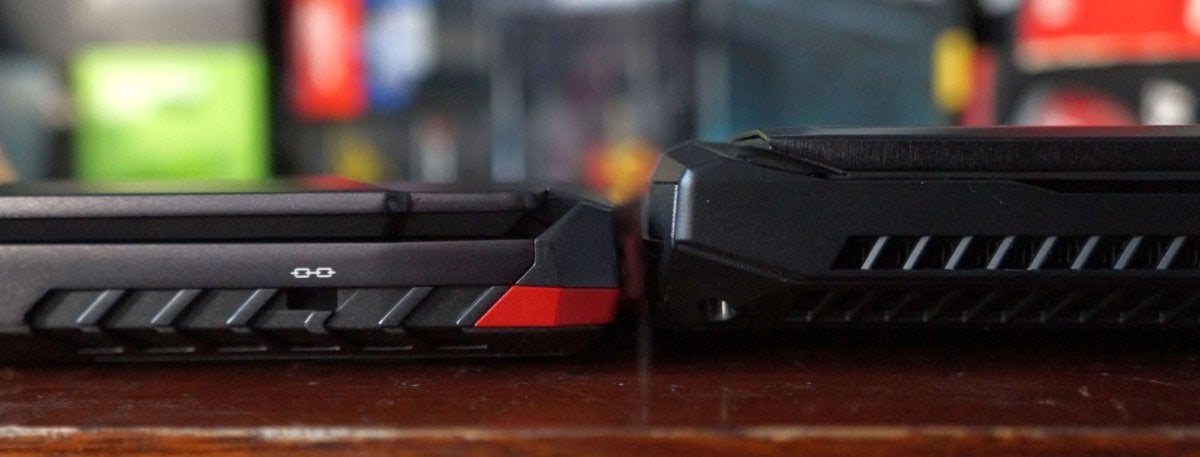 Brad Chacos/IDG
Brad Chacos/IDG The PowerSpec 1710 (left) is dilutant than the PowerSpec 1510 (right).
The 17.3-column inch laptop naturally measures in a bit wider and longer than its littler full cousin, at 16.5 x 11.5 inches. Despite that it appears sleeker to my eye collectible to being unmatchable inch thick—a quarter-in thinner than the PowerSpec 1510. The decision to reduce the height may not have been a smart one, though. The PowerSpec 1710 suffers from low execution during extended usage, while the PowerSpec 1510 doesn't. We'll cover that in detail during the performance section.
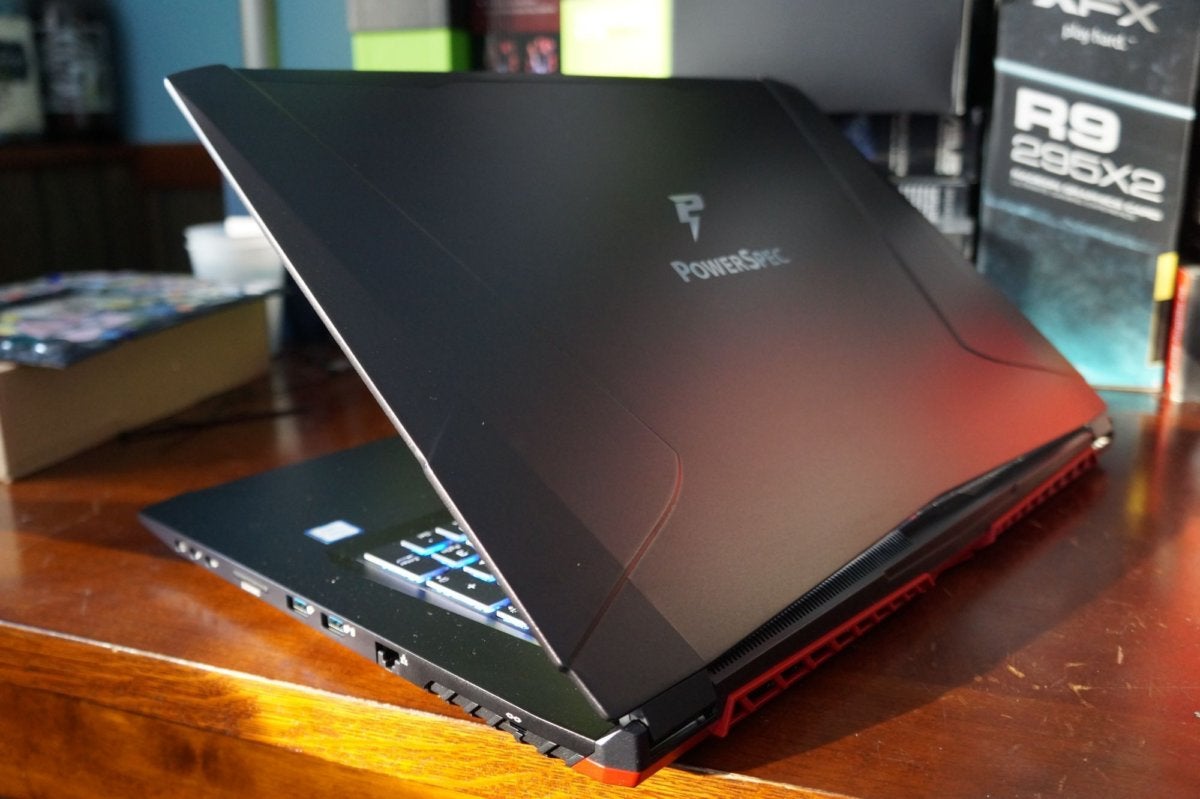 Brad Chacos/IDG
Brad Chacos/IDG The PowerSpec 1710's rear eat is red, inexplicably.
The angular rear exhausts on the PowerSpec 1710 are piebald an obnoxious "gamer coloured" color that coordinates with a pair of red RGB lights on either side of the triangular power push found front and pith underneath the display. The PowerSpec 1510 sticks to smuggled atomic number 13 passim, augmented by blue lighting under its keyboard and a more subdued rectangular power button. That better fits my personal tastes, though both laptops admit software program that let you customise the keyboard's RGB backlighting aside region.
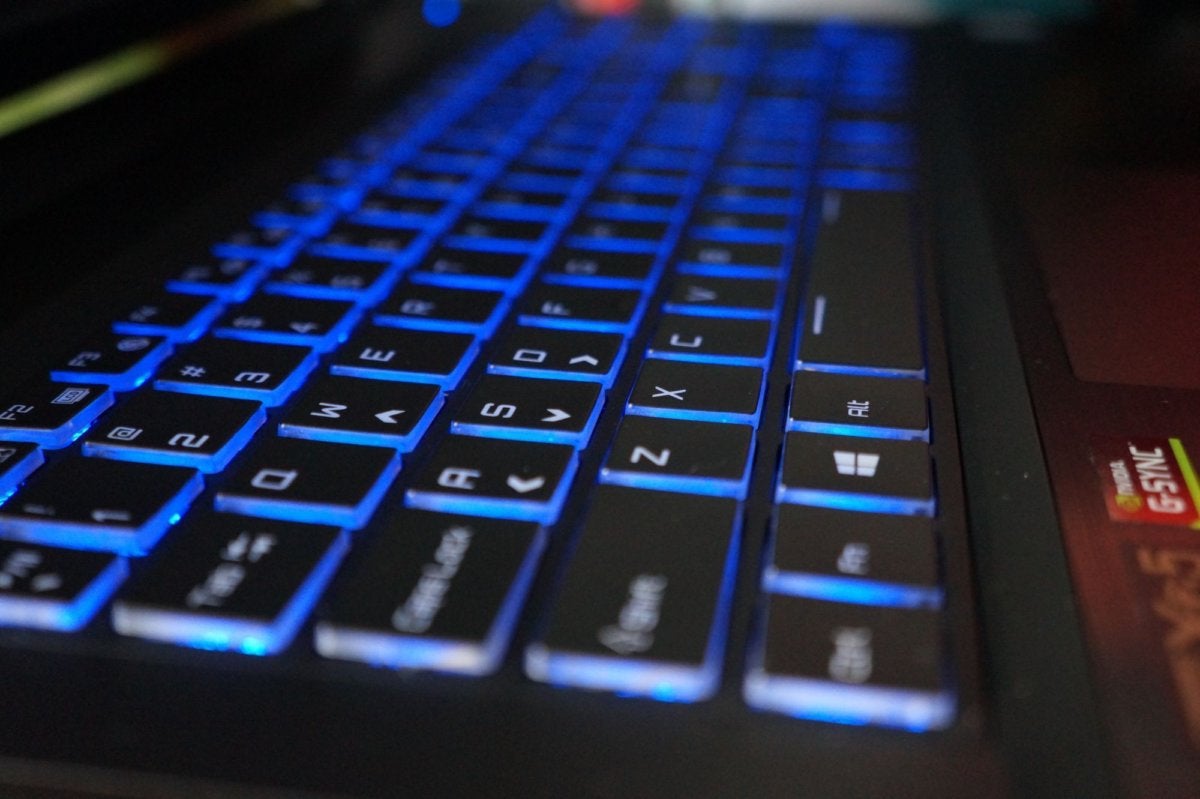 Brad Chacos/IDG
Brad Chacos/IDG Both PowerSpec laptops fun standard-issue Clevo keyboards. They're as eh, okay as ever. I favour the deeper key travel of the PowerSpec 1510; the shallower keys of the PowerSpec 1710 bottom out more frequently and feel inferior comfortable. The touchpads testify velvet and accurate, though the buttons are a trifle overly mushy—another common Clevo complaint. The PowerSpec 1510 embeds a fingerprint reader between those buttons, while the PowerSpec 1710 lacks any biometric support.
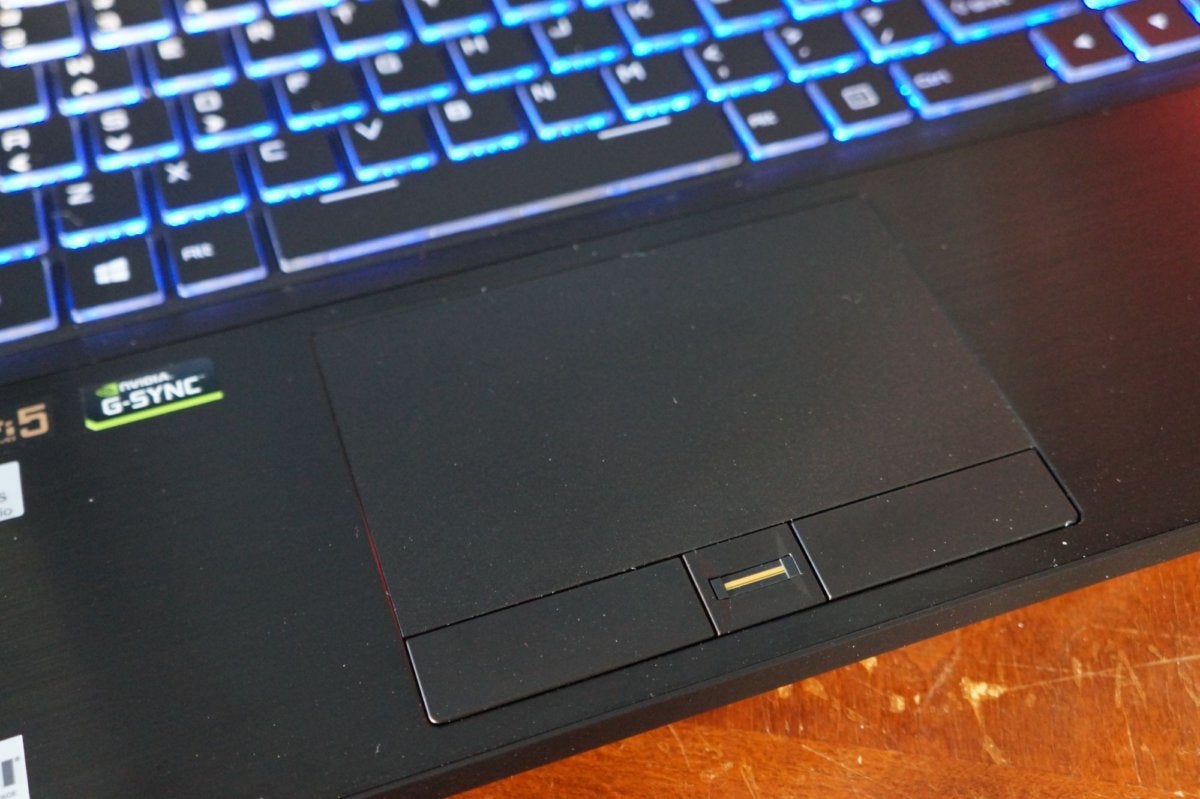 Brad Chacos/IDG
Brad Chacos/IDG The PowerSpec 1510's touchpad includes a fingerprint reader.
Audio differs between the 2 laptops arsenic well. SoundBlaster handles the PowerSpec 1710's sound, and the results are adequate. The laptop computer gets nice and loud, but kind of claxon-y at high bulk. The audio can also sound curiously flat sometimes, though IT's clear overall and has a decent bass punch. The PowerSpec 1510 also packs SoundBlaster tech, but information technology's bolstered past an ESS Sabre HiFi DAC and Texas Instruments Burr-Brown Audio. It sounds surprisingly nifty, with crisp, unmistakable tones. Abyssal bass adds a caring feel. But the supreme volume is also surprisingly quiet—you North Korean won't be cranking this notebook to 11. As ever, we recommend purchasing a Nice gaming headset to twain with your gaming laptop.
Side by side page: Benchmarks and purchasing advice
PowerSpec laptop performance
The $1,300 PowerSpec 1510 and $1,400 PowerSpec 1710 deliver a hell of a lot of bang for your buck, be it in gaming, content creation, or some. Finding laptops packing this raze of hardware for under $1,500 is almost impossible, especially with G-Sync (eventually) enclosed. The similarly specification'd Alienware 15 R3 costs $2,000 on Virago, e.g., though its 1080p display refreshes twice atomic number 3 often. Hell, laptops with a less able GTX 1060 sometimes cost more than these Micro Center machines.
Let's take them to the test judiciary.
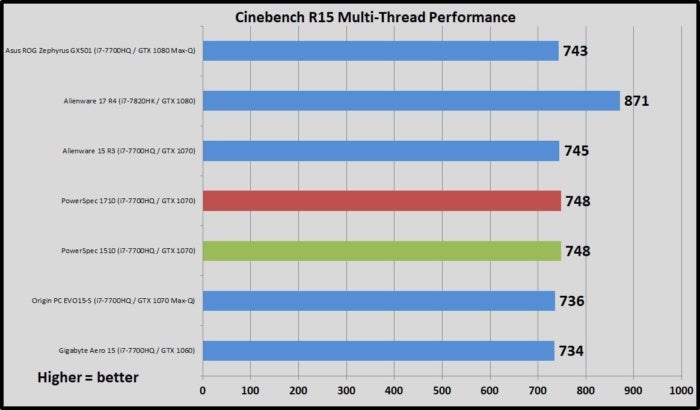 Brad Chacos/IDG
Brad Chacos/IDG Maxon's Cinebench R15 measures raw CPU performance, and the more duds you can throw at it, the happier it is. Umpteen of nowadays's high-end gaming laptops lean on the same Intel Nub i7-7700HQ, and thus deliver interchangeable results with some nonaged variations due to cooling intention differences. Only the beastly Alienware 17 ($2,599 as configured along Dell) edges in the lead of the crowd thanks to its more powerful Core i7-7820HK CPU.
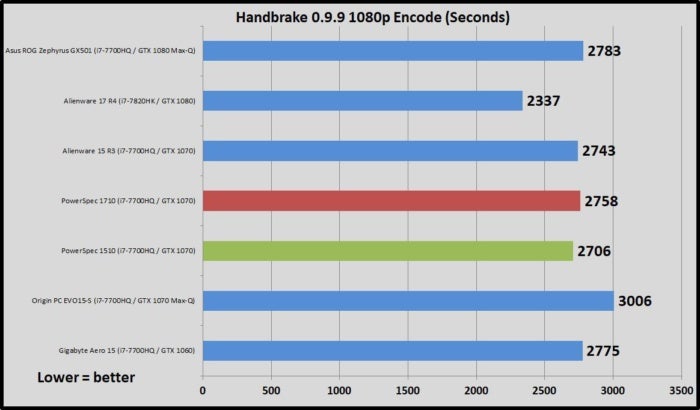 Brad Chacos/IDG
Brad Chacos/IDG Deeper differences between the contrive of the PowerSpec 1510 and PowerSpec 1710 became obvious in our next test, which mostly focuses on CPU carrying out as well. The Cinebench test has a short run clock time, but the file we cipher in our HandBrake test (which uses an older version of the software) takes around 45 minutes on a quadruplet-core CPU. The extended duration reveals how a laptop's temperature strangulation affects performance over time.
The thicker PowerSpec 1510 delivers the best scores among the legion of Core i7-7700HQ laptops; the PowerSpec 1710 clocks in 52 seconds slower. Indisputable, that's only a instant or so's difference between the cardinal in world, but we'll also see survival concerns during gambling benchmarks that strain both the CPU and the GPU.
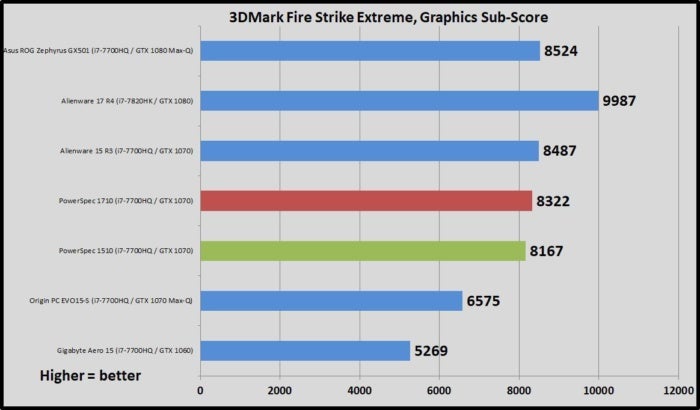 Brad Chacos/IDG
Brad Chacos/IDG Public speaking of which, graphics are the hotshot of the show in play laptops. We test the visual chops of gambling laptops using 3DMark's Fire Strike Extreme benchmark. Specifically, we rely on the Graphics submarine-score, which focuses on clean GPU performance. The overall score takes more hardware factors into account and is less useful for our needs.
Present you see the might of the fully enabled GeForce GTX 1070. The PowerSpec laptops turn in graphics mountain shut down to the similarly equipped $2,000 Alienware 15 R3's. But Micro Eye's laptops good trounce rival notebooks packing Nvidia's late GTX 1070 Max-Q crisp for a fraction of the toll, like the $2,199 Gigabyte Aero 15X and $2,375 Beginning EVO15-S. Max-Q enables Sir Thomas More all-powerful GPUs to squeeze into thin and lightsome frames, but need to be severely underclocked to achieve that portability. In fact, the unleashed GTX 1070 inside the PowerSpec 1510 and 1710 are only a fuzz slower than the GTX 1080 Max-Q saved at bottom the Asus ROG Zephyrus—a premium Max-Q flagship that, at $2,700, costs nearly double that of Micro Center's machines.
That trend continues when it comes to actual gaming benchmarks.
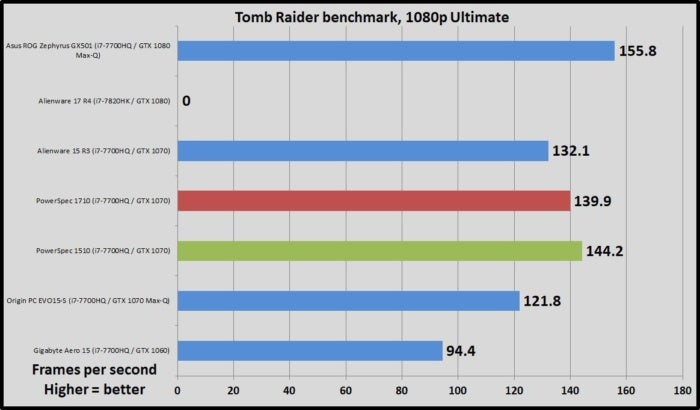 Brad Chacos/IDG
Brad Chacos/IDG 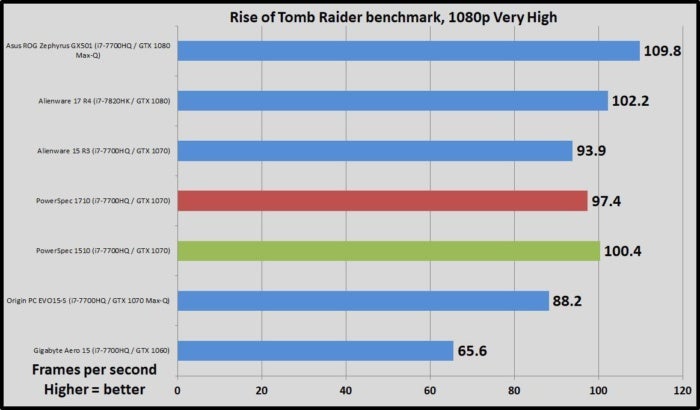 Brad Chacos/IDG
Brad Chacos/IDG 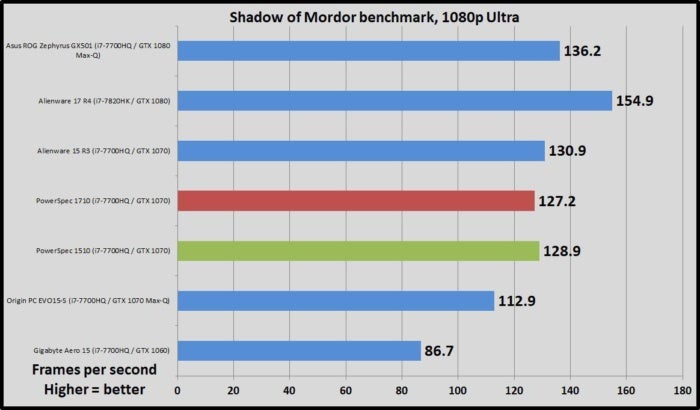 Brad Chacos/IDG
Brad Chacos/IDG Note that the PowerSpec 1510 comes in slightly ahead of the PowerSpec 1710 crosswise the board—that's the difference in design and caloric strangulation coming into play. Like Cinebench, gaming benchmarks incline to be pretty short-range, so I repeatedly run the Rise of the Tomb Raider benchmark for an hour, noting the differences in physical body rate from the first off to the last run. The PowerSpec 1510 delivered essentially the same experience throughout, with frame rate fluctuations inside of 1 redact per second. But the extended test hammered the larger PowerSpec 1710. It started slay hit 97.42 fps in the gamy; afterward an hour, it hit 92.31. That's a 5-percentage performance hit under extended lade—not something you see very often.
The PowerSpec 1510's fans aren't overly quiet when the laptop's under encumbrance, but they aren't too loud either. That's around the best you can invite in a play laptop. On the other handwriting, the PowerSpec 1710's fans are much more audible, and emit an vexatious high-pitched whir. You behind't hear either with gaming headsets along, but the barista at Starbucks would like you a lot more if you left the PowerSpec 1710 at home.
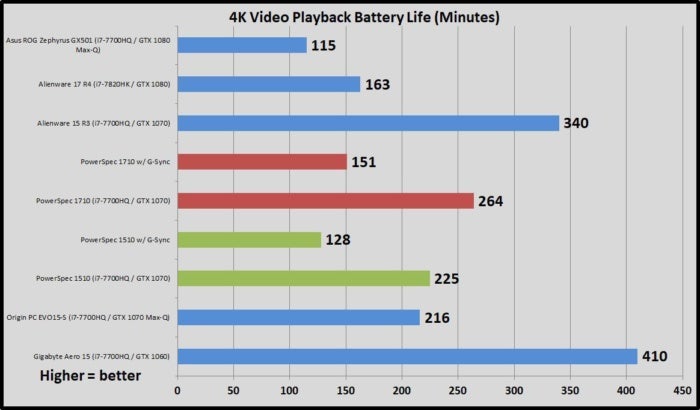 Brad Chacos/IDG
Brad Chacos/IDG We test battery life by looping a 4K video in Windows 10's built-in Movies & TV television player, with the show brightness set to 250 to 260 nits—that's bright adequate to watch well in an business office environment.
In the stock constellation, with Microsoft Hybrid Graphics enabled, the barrage fire life is in reality pretty darn decent for a gaming laptop. The PowerSpec 1710 and its nearly 67 watt-hour barrage lasts 264 minutes (4 hours, 24 minutes), roughly 39 minutes longer than the PowerSpec 1510, which has a smaller 60Whr excite.
Activating the discrete nontextual matter to get G-Synchronise awake and running devastates the endurance of Micro Center's laptops, as you'd expect. With the GTX 1070 flying constantly, the PowerSpec 1510 lights-out out at 151 proceedings (2 hours, 31 transactions), 97 proceedings sooner than it did with Hybrid Graphics enabled. The PowerSpec 1710 dies at 128 minutes (2 hours, 8 proceedings), a whopping 113 minutes—nearly two full hours—rather than before.
Those are among the worst results we've seen in a gaming laptop. If you architectural plan to be out on tour for the day and don't want to drag your charger on with you, consider switching hindermost over to Hybrid Graphics.
Should you buy in the PowerSpec 1510 and 1710?
Micro Center's $1,300 PowerSpec 1510 and $1,400 PowerSpec 1710 deliver a staggering amount of bang for your buck. Laptops with beefy computer hardware loadouts care this typically be several hundreds more, and oft cross the $2,000 range. Seriously: These are both damned, damned good deals if you want a powerful gaming notebook without breaking the bank. The exceptional displays and aluminum exteriors are fair-minded desserts after the hardware buffet.
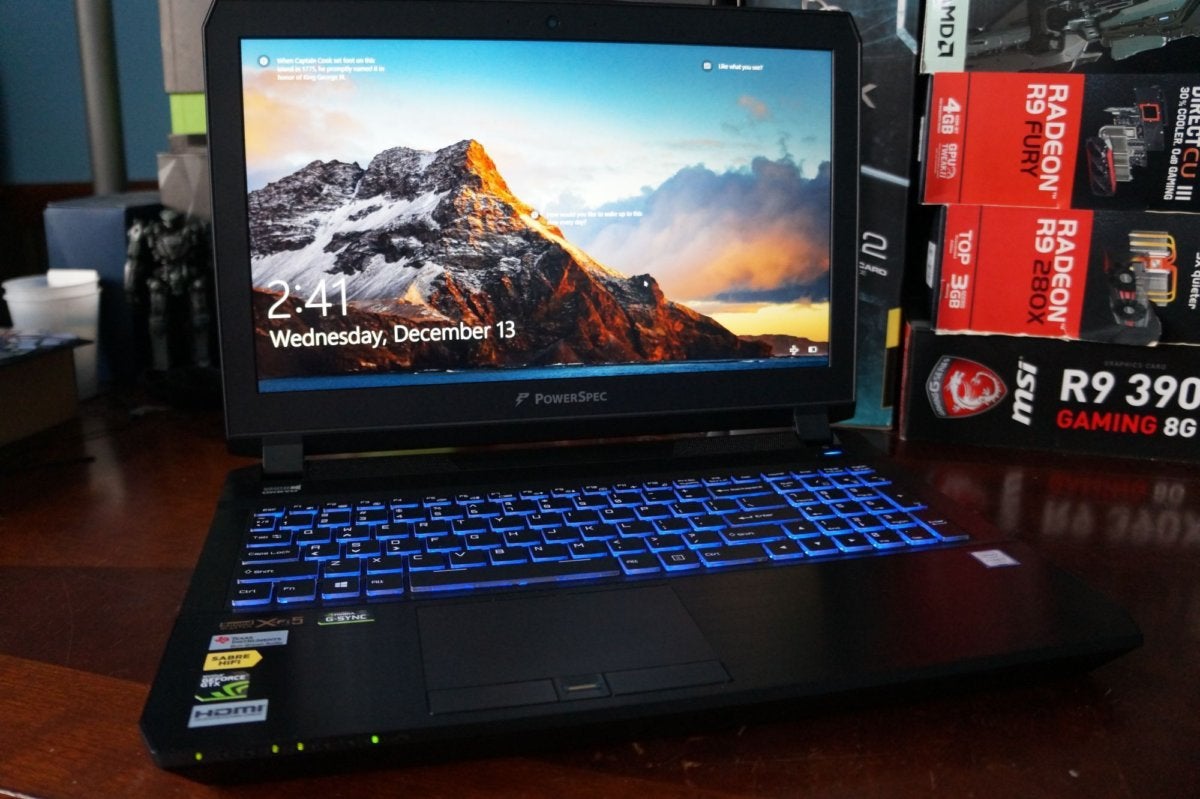 Brad Chacos/IDG
Brad Chacos/IDG The PowerSpec 1510 is the better buy.
The low cost comes at a price, though. These are prototypical galactic, heavy gaming laptops. The determination to ship them with a flagship feature like G-Sync disabled and hidden out behind esoteric BIOS menus is downright perplexing, even pickings G-Sync's battery sprightliness hit into account. The PowerSpec 1710 also suffers from an annoying fan, Thomas More overtly aggressive "gamer" aesthetics, and a thermal visibility that can result in noticeable performance degradation during extended use.
Altogether, the PowerSpec 1510 delivers a to a greater extent cured-rounded experience with no serious flaws. I'd heartily recommend it over the PowerSpec 1710 even if you lean to skeletal towards larger screen sizes. Merely some of these are downright steals if you live near a Micro Center and are fit to pick one up. $1,300 for altogether this is ridiculous. On that point's no GTX 1070-equipped laptop we backside even point to as a match in this price graze. If you craved to puzzle this level of index in a thin Italian sandwich-five-pound laptop, you'd need to measure up to a GTX 1080 Max-Q machine like the Asus ROG Zephyrus, which costs $2,700—more than than twice the price of Micro Center's embonpoint, cheap offerings.
Sporting be certainly to enable G-Sync for the best gaming feel for—and maybe invalid it again if you wander departed from your charger.
Best Prices Today
Note: When you purchase something later clicking links in our articles, we whitethorn earn a small commission. Read our consort link policy for more details.
Brad Chacos spends his days digging through desktop PCs and tweeting overmuch.
Source: https://www.pcworld.com/article/407735/powerspec-1710-powerspec-1510-review.html
Posted by: alcantarweldess1952.blogspot.com


0 Response to "PowerSpec 1710 and PowerSpec 1510 review - alcantarweldess1952"
Post a Comment